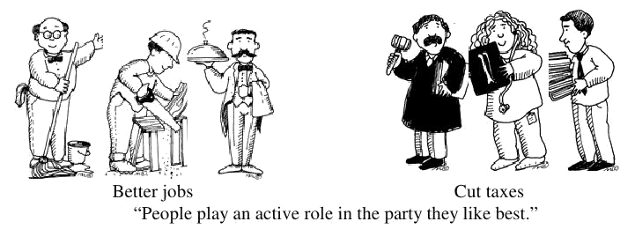Read the Previous Principle, read Conclusion of Story, or Return to table of contents
Principle 18: Various political parties express differing political points of view. People support the party of their choice.

Political parties are very important in the life of a democracy. Ordinary people play very active roles in political parties. There are many opinions about what laws should be passed. And people disagree about how much government should be involved in the details of society. There are many views about how a country should relate to its neighbors. But all opinions deserve to be heard! In a democracy, these ideas are expressed in political parties. One political party stands for a set of ideas, and another party stands for a different set of ideas. That way, all the major ideas get heard. People work very hard in their political party to bring the message of their party to the people. They make signs; they put ads on television and radio and in the newspaper. They talk to their neighbors and friends. They raise money. They want to promote the ideas of their party. If they convince enough people that their ideas are good, those ideas may become law.
Story:
Partly why Ramon seemed ok again was because he was heading up the Tell It Like It Is political party. The party idea was that it is good for people to speak when they think they have been wronged. Ramon loved being a leader and speaking out for what he believed. He complained a lot about the yellow arm bands issue. Some felt he just liked to complain. Several others who liked to complain joined the political party. This political party felt that “being brave enough to speak out” was a good thing. Others felt the Tell Like It Is party was not brave at all. They felt like it was really for people who like to complain. However, like most political parties, Ramon and his friends made signs, held meetings and did everything they could to get more kids to join with them. It was when Nadesh and Petra saw it was growing that they decided to do something. They gathered their friends.
Petra started. ”The Tell It Like It Is party likes to complain!” She continued, “All they do is say what is wrong. They never have solutions. We need a political party that has solutions!” The group around her clapped their hands.
“Let’s call it the Solutions party,” suggested Nadesh. “Sure, it is ok to complain sometimes, but it is always better to come up with a solution. You can’t fix the world with complaints!”
“Maybe this could be our slogan,” Sahara said. “Solutions Save the Day.”
The group liked it. The party members got real involved in meetings, sign-making, making speeches and doing whatever they could to see to it their ideas got accepted on voting day. The competition was intense as the two parties each tried to get people to support their ideas.
“I had no idea people would work so hard in the political party,” Nadesh said to Petra one day. “They really want their ideas to win, don’t they?”
“I think so,” Petra replied. “They see that working hard in the political party is their best chance of getting their ideas accepted. Most of our members won’t win a position in government. Working at the party level is their best chance to get heard.”
“Come on! Let’s get back to work,” scolded Sahara, “We don’t want them to get ahead of us! Remember, if they win, we have to live with their ideas.” Back to work they went. They so hoped their political party would win. Of course, the other party felt just as strongly and wanted their ideas to win. Both sides played fair. Both sides played hard. Both sides wanted to win! To be continued....
Activity: Select two popular students and place one on each side of the room. Without the other children hearing, instruct one student to say he/she represents the Jobs party. Their party goal is to get more jobs for the people. He/she will give a little talk to convince the class to join his/her political party. Then, instruct the other student to say that he/she represents the Health and Roads party. Their party goal is to provide better roads and better health care. Now, with some coaching from you, if needed, let each party representative give a talk promoting their party. After the two talks, lead a brief discussion of the differing party viewpoints. Students must choose which one party they will join. Stop the discussion before consensus can form. The exercise is more interesting when there are people on each side who feel strongly about supporting their favorite party. Then let the students go to the side of the room where their favorite political party is. Point out the relative size of each party. Then have students return to their seats. Explain that the next step would be—if these were real political parties—to go out into the community and try and convince others to join with them to (1) vote for their candidates in the election, and (2) to support their ideas being made law. Then discuss the experience with the class. Are they surprised about the relative size of the two parties? What other ideas might political parties be organized around? What methods or techniques might be used to convince the public to support their candidates and their political ideas? Was either party perfect? Did they like some ideas of one party and also some ideas of another party? Deciding which party to support is a regular part of democracy. It is how the people exercise their power.
Read the Previous Principle, read Conclusion of Story, or Return to table of contents